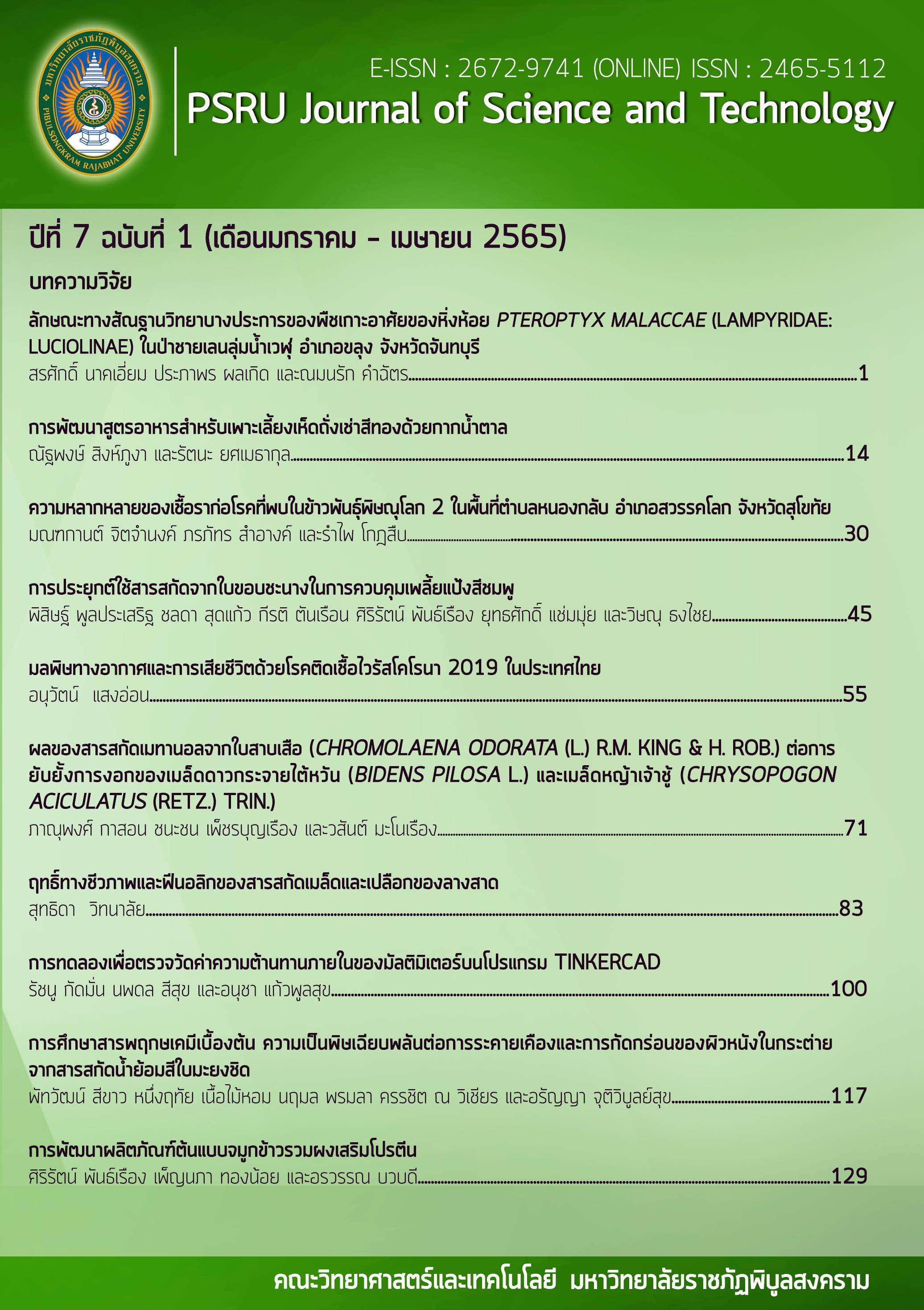DIVERSITY OF FUNGI ON RICE VARIETY PHITSANULOK 2 IN NONGKLAB, SAWANKHALOK, SUKHOTHAI PROVINCE
Keywords:
ข้าวพันธุ์พิษณุโลก 2, โรคข้าว, เชื้อราAbstract
Rice disease caused by fungi is very devastating to the rice yield. The objective of this research is to study diversity of fungi on rice variety Phitsanulok 2 in Nongklab, Sawankhalok, Sukhothai province. Thirteen rice samples were collected from the field in two sampling times. Isolation of the fungi has been done by using tissue transplanting technique on PDA medium, then transferred fungal hyphal tip to new petri dish. Totally 43 isolates of fungi have been obtained, where 39 isolates are sporulated and 4 isolates are non-sporulated ones. Identification of the fungi was done based on morphological characteristics of fungal colony, growth characteristics of mycelium and spore production. Microscopic characteristics of fungi were then examined under compound microscope using slide culture technique. Generic name of each fungus was specified by comparing the information with relevant documents. Identification results showed that sporulated fungal isolates are belong to the following genera viz Alternaria, Aspergillus, Bipolaris, Curvularia, Nigrospora and Scopulariopsis, while non-sporulated isolates were classified as unidentified mycelia-sterilia. The dominant fungal genera found in this study are Curvularia spp. (11 isolates; 25.58%), Nigrospora spp. (10 isolates; 23.26%) and Aspergillus spp. (8 isolates; 18.60%), respectively.
References
ดารา เจตนะจิตร, นงรัตน์ นิลพานิชย์, พากเพียร อรัญนารถ, วิชิต ศิริสันธนะ, วิชชุดา รัตนากาญจน์, รัศมี ธิติเกียรติพงศ์, วันชัย โรจนหัสดิน, และธัญลักษณ์ อารยาพันธ์. (2550). โรคข้าวและการป้องกันกำจัด (หนังสืออิเล็กทรอนิกส์). กรุงเทพฯ: โรงพิมพ์ชุมนุมสหกรณ์การเกษตรแห่งประเทศไทยสำนักวิจัยและพัฒนาข้าว กรมการข้าว.
ธีราพร จันทร์ศรี, อัปสรสวรรค์ ใจบุญ, กีรติ ตันเรือน, พิสิษฐ์ พูลประเสริฐ, รัตน์ติพร สําอางค์, รําไพ โกฎสืบ, และเรืองวุฒิ ชุติมา. (2563). การสำรวจและการแยกเชื้อราไมคอร์ไรซาจากกล้วยไม้ดินสกุล Spathoglottis ที่ปลูกในกระถาง, PSRU Journal of Science and Technology 5(3), 127-138.
ประภัสสร สีลารักษ์, และเพชรรัตน์ ธรรมเบญจพล. (2559). การถ่ายทอดทางเมล็ดพันธุ์ของเชื้อฟิวซาเรียมสาเหตุโรคถอดฝักดาบของข้าวและศักยภาพของเชื้อ Streptomyces-PR15 และ Streptomyces-PR87 ในการควบคุมโรคจากเชื้อฟิวซาเรียมของพืชเศรษฐกิจ, แก่นเกษตร, 44(ฉบับพิเศษ 1), 238-245.
พรศิลป์ สีเผือก, วุฒิชัย สีเผือก, และชัยสิทธิ์ ปรีชา. (2561). ความหลากหลายของเชื้อราในนาข้าวและการคัดเลือกเชื้อแบคทีเรียปฏิปักษ์เพื่อควบคุมโรคข้าวโดยชีววิธี (รายงานการวิจัย). นครศรีธรรมราช: มหาวิทยาลัยเทคโนโลยีราชมงคลศรีวิชัย.
รัตนากร กฤษณชาญดี. (2560). การจำแนกเชื้อราสาเหตุโรคพืชในเมล็ดพันธุ์ข้าวไร่ในภาคใต้และภาคเหนือ (รายงานการวิจัย). ชลบุรี: มหาวิทยาลัยเทคโนโลยีราชมงคลตะวันออก.
ศิริรัตน์ ศิริพรวิศาล. (2550). การศึกษาความหลากหลายของรา Bipolaris oryzae และความสำคัญต่อการเกิดโรคใบจุดสีน้ำตาลในพื้นที่เพาะปลูกข้าวนาปรัง จังหวัดพระนครศรีอยุธยา (รายงานการวิจัย). อยุธยา: มหาวิทยาลัยราชภัฏพระนครศรีอยุธยา.
สาขาวิชาจุลชีววิทยา. (2561). ปฏิบัติการจุลชีววิทยา. คณะวิทยาศาสตร์และเทคโนโลยี, มหาวิทยาลัยราชภัฏพิบูลสงคราม. 55-56.
สำนักงานสถิติแห่งชาติ (2561). การสำรวจการเปลี่ยนแปลงทางการเกษตร พ.ศ.2561 สำนักงานสถิติแห่งชาติ กระทรวงดิจิทัลเพื่อเศรษฐกิจและสังคม. สืบค้นเมื่อวันที่ 19 กุมภาพันธ์ 2563, จาก http://www.nso.go.th/sites/2014/Pages/News/2562/N30-07-62-1.aspx
สำนักวิจัยและพัฒนาข้าว กรมการข้าว. (2543). ข้าวพันธุ์พิษณุโลก 2. สืบค้นเมื่อวันที่ 19 กุมภาพันธ์ 2563, จาก http://www.ricethailand.go.th/rkb3/title-index.php-file=content.php&id=114.htm
อารียา ประเสริฐกรรณ์, และรำไพ โกฎสืบ. (2562). การศึกษาเชื้อราที่ก่อโรครากเน่าในมันสำปะหลัง ในเขตอำเภอวังทอง จังหวัดพิษณุโลก. ใน การประชุมสวนสุนันทาวิชาการด้านวิทยาศาสตร์และเทคโนโลยีระดับชาติและนานาชาติ ครั้งที่ 2: “วิทยาศาสตร์ เทคโนโลยี และนวัตกรรมเพื่อการพัฒนาที่ยั่งยืน” (น. 31-39). กรุงเทพฯ: มหาวิทยาลัยสวนสุนันทา.
Carmichael, J.W., Kendrick, W.B., Conners, I.L., & Sigler, L. (1980). Genera of Hyphomycetes. Edmonton, Canada, University of Alberta Press.
Ellis, M.B. (1971). Dematiaceous Hyphomycetes. UK: Commonwealth Mycological Institute.
Ellis, M.B. (1976). More Dematiaceous Hyphomycetes. UK: Commonwealth Mycological Institute.
Gopalakrishnan C., Kamalakannan, A., & Valluvaparidasan, V. (2010). Survey of seed-borne fungi associated with rice seeds in Tamil Nadu, India, Libyan Agriculture Research Center Journal International, 1(5), 307-309.
Lapmak, K., Lumyoung, S., Wangsapa, R., & Sardsud, U. (2009). Diversity of filamentous fungi on brown rice, Pattalung Province, Thailand, International Journal of Agricultural Technology, 5(1), 129-142.
Li, X.L., Ojaghian, M.R., Zhang, J.Z., & Zhu, S.J. (2017). A new species of Scopulariopsis and its synergistic effect on pathogenicity of Verticillium dahliae on cotton plants, Microbiological Research, 201, 12-20.
Song W., Zhou L., Yang C., Cao X., Zhang L., & Liu, X. (2004). Tomato Fusarium wilt and its chemical control strategies in a hydroponic system, Crop Protect, 23, 243–247.
Sutton, B.C. (1980). The Coelomycetes. UK: Commonwealth Mycological Institute.
Downloads
Published
How to Cite
Issue
Section
License
Copyright (c) 2022 PSRU Journal of Science and Technology

This work is licensed under a Creative Commons Attribution-NonCommercial-NoDerivatives 4.0 International License.
กองบรรณาธิการขอสงวนสิทธิ์ในการปรับปรุงแก้ไขตัวอักษรและคำสะกดต่างๆ ที่ไม่ถูกต้อง และต้นฉบับที่ได้รับการตีพิมพ์ในวารสาร PSRU Journal of Science and Technology ถือเป็นกรรมสิทธิ์ของคณะวิทยาศาสตร์และเทคโนโลยี มหาวิทยาลัยราชภัฏพิบูลสงคราม และ
ผลการพิจารณาคัดเลือกบทความตีพิมพ์ในวารสารให้ถือมติของกองบรรณาธิการเป็นที่สิ้นสุด







